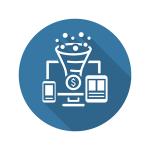
Getting that first “yes” from a customer is hard enough that many sales pros might not want to take the risk of going too far and pitching additional products, services or features. Seasoned B2B buyers are well acquainted with upselling, and will not always react well to the suggestion that they should increase their investment.
In the worst-case scenario, upselling comes across as an act of greed. Positioned properly, however, the upsell is really a way for a company to increase its value to customers. It only works if the vision of success a sales rep paints is so crystal-clear that it looks less like a pitch than a plan to further the customer’s success.
Upselling is particularly critical for Canadian SMBs who may not have a large or diverse client base (at least in the beginning) on which to grow their revenues. That means working within the base you have and ensuring you maximize revenue per customer to the fullest extent possible. Here’s how:
Set A CRM Goal
As you gather data and information in CRM, look at what kind of insights would most likely lead to an upselling opportunity and design your approach accordingly. After every prospect meeting, reps should come back with an understanding of the following:
-
Renewal cycle: What is the prospect’s typical budget and spending periods, and when are the “blackouts?” This should be communicated to whoever handles marketing to ensure content for nurturing demand is scheduled appropriately.
-
Cost per acquisition: Not to be confused with traditional lead generation, ensure reps have understood what levels of approvals a buyer or buying team may need to work through in order to make a purchase, and the length (weeks, months, quarters) that cycle tends to last. The longer the cycle, the more thoughtful any upselling pitch will have to be.
- Support and churn ratios: If you’re getting a prospect to switch to your products from a rival company, make sure reps understand what went wrong and why. Customers that require more assistance to be successful with a product or service (or who are quick to abandon suppliers with whom they are successful) will be expensive to manage. They also tend to be the most unlikely candidates for an upsell.
Think Beyond The Renewal Phase
When a contract is getting close to the end of its life, some companies will have alerts within CRM set up to make sure reps are reaching out about continuing on. That may already be too late for an upsell, though, because if the customer isn’t renewing, they’re not going to deepen their investment. Even if you’re dealing with a satisfied customer who’s prepared to renew their relationship, they may see an upsell as a pushy way to wring more dollars from their already-stretched budgets.
Great sales teams can transcend these scenarios by becoming their customers’ most loyal and engaged audience. If your customer publishes a blog on its activities and achievements, bookmark it. If they publish an email newsletter, subscribe. If they use video to offer webinars, tune in. As you get better acquainted with their day-to-day activities, keep watch for the following upsell moments:
-
New product launches or upgrades: When B2B companies bring something new to market, they are often more prepared to make purchases on products and services that will get them better known, speed up their business processes or reduce what they’re spending in other areas. If your firm’s products can contribute to any of these opportunities, that’s when you should see if you can help with an upsell.
-
M&As and competitor success: You may not own all the potential customers in a sector, but you should keep watch on as many as possible. If you customer’s rival has been bought up by a larger company, for example, there may be a chance to upsell your customer with products and services that will make them more competitive. Same goes for big wins: If your customer’s rival has scored a major milestone, an upsell should be focused on how you can help them do the same.
-
Industry conferences and events: If your customer is attending something to educate themselves on changes in the market or trends that will shape their sector, think about what you can offer as a followup. Sometimes an upsell only needs to be an incremental (but meaningful) addition to the investment they’ve already made.
Break Buying Teams Apart
The rise of account-based marketing happened because more companies are realizing that their “customer” may represent multiple contacts who discuss and then make the final call about certain investments together. Sales reps may only typically interact with one member of this team, but that doesn’t mean the others should be ignored.
Instead, think about the needs that span across a customer set and where you could influence a deeper relationship. If you sell into the IT department, for instance, discuss the needs of the marketing function and how your firm’s products and services could help. Or learn about the way HR processes work and how you could address some of their challenges.
Even if you’re not able to upsell the decision-maker you know well, you might at least show them you think about how to contribute to the overall organization’s success.
Upsell Across Channels
Upselling might seem too confrontational during a pitch meeting or as a deal is closing, but that’s probably not the only time you have a customer conversation. Sales and marketing teams are already working more closely together, but upselling is a great example of where a strong partnership could really pay off. Where else do your customer relationships exist, and how could you align upselling? A few ideas:
-
Email: If you’re sending thank you emails from an event or even an account renewal notice, craft simple but compelling offer that might be hyperlinked to content marketing assets that help make the upsell more natural to your audience.
-
Social: Customers may already follow your accounts on Twitter, LinkedIn or similar services in order to have a direct customer support channel. This can also be effectively used for light but enticing upselling, especially if you can tie in offers to trends in a particular industry or other news they’re seeing in their feeds.
-
App: As more companies develop a “mobile-first” strategy, they’re realizing that they don’t merely have an opportunity to let customers conduct transactions or even just research their products and services. They also have a natural way to upsell them based on what they’ve looked up, how they navigate through an app and what data they offer. This should be in your game plan, too.
You may never hear customers express gratitude for attempting an upsell out loud, but if they agree to increase the level of business they do with you, it will mean a lot more than “thanks.” It will jumpstart your journey towards an increasingly profitable customer base.



























